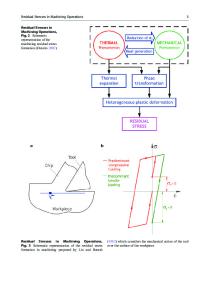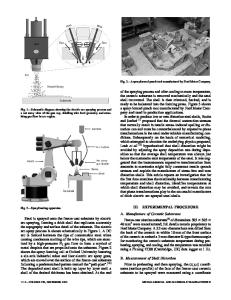Residual stresses in spray-formed A2 tool steel
- PDF / 266,370 Bytes
- 10 Pages / 612 x 792 pts (letter) Page_size
- 74 Downloads / 394 Views
MATERIALS RESEARCH
Welcome
Comments
Help
Residual stresses in spray-formed A2 tool steel H.M. Hu and E.J. Lavernia Department of Chemical and Biochemical Engineering and Materials Science, University of California at Irvine, Irvine, California 92697
Z.H. Lee Department of Materials Science and Engineering, ROSAM, KAIST, Taejon, 305-701, Korea
D.R. White Materials Systems Reliability Department, Ford Research Laboratory, Dearborn, Michigan 48121 (Received 13 June 1999; accepted 30 September 1999)
The objective of this work was to investigate the fundamental factors that govern the formation and magnitude of residual stresses in A2 tool steel fabricated using spray-forming techniques. To that effect, a finite-element method (FEM) was performed by using a commercial code, ABAQUS, to solve for the temperature and displacement fields. Moreover, the residual stresses in the spray-formed materials were measured using x-ray diffraction to compare the FEM results with experimentation. Two types of substrate material, copper and Rescor™ 780 cer-cast ceramic, were used to investigate the influence of heat conduction on residual stress in the preforms. Relatively good agreement was found between experimentation and theory. The results show that the residual stress varies greatly with the position in deposited preform and that heat-transfer coefficient at the interface of spray-formed material/substrate affects the distribution and magnitude of the residual stresses significantly.
I. INTRODUCTION
Spray forming involves the generation of two- or three-dimensional components via the accumulation of individual droplets. The size characteristics of the droplet dispersion depends on the methodology used to generate the droplets (i.e., melt atomization, twin-wire arc, plasma field, etc.), although a Gaussian size distribution function is often used to describe the droplet sizes. Early studies on spray-formed intermetallics (Ni3Al, TiAl),1–3 refractory alloys (Ta–Fe),4 and steels5–8 showed that physical performance (i.e., fracture strength, fatigue life, formability, etc.) is readily improved, generally as a result of the microstructural requirement that is inherent to fine droplets and particles.7,8 More recent efforts are aimed at the implementation of a rapid prototyping technology that can be efficiently used to produce net shapes of difficult to fabricate materials such as tool steels, directly from a droplet dispersion (e.g., spray). Tool steels (i.e., A2, D2, etc.) are excellent candidates for rapid-prototype spray forming, since commercially available fabrication routes are expensive and, most importantly, time consuming. An important aspect of sprayforming technology which has received only limited attention in the literature, and which is particularly important in the case of tool steels, is the formation of residual stresses. Any residual stresses that may be presJ. Mater. Res., Vol. 14, No. 12, Dec 1999
http://journals.cambridge.org
Downloaded: 15 Mar 2015
ent in spray-formed tools can be detrimental to service
Data Loading...











